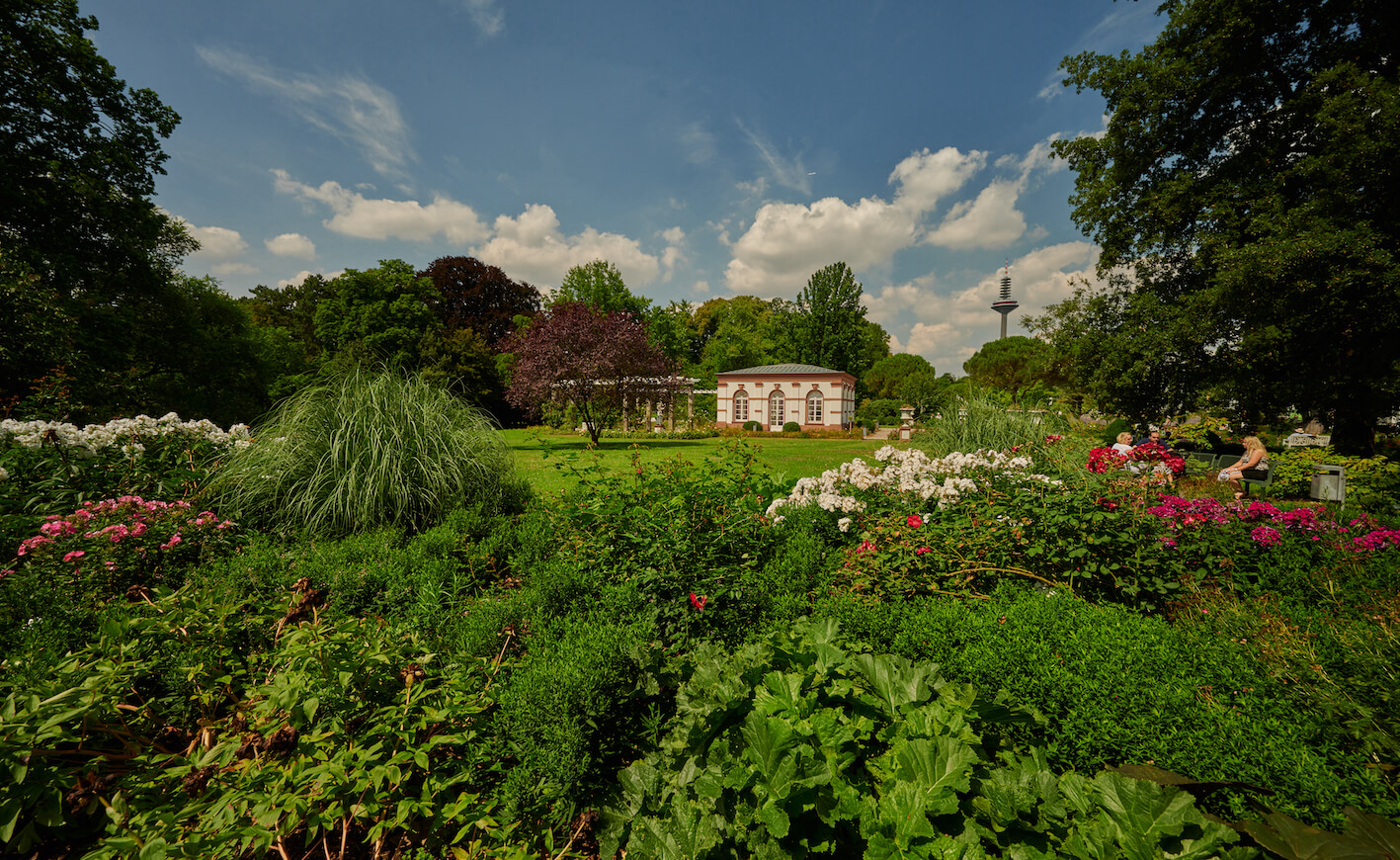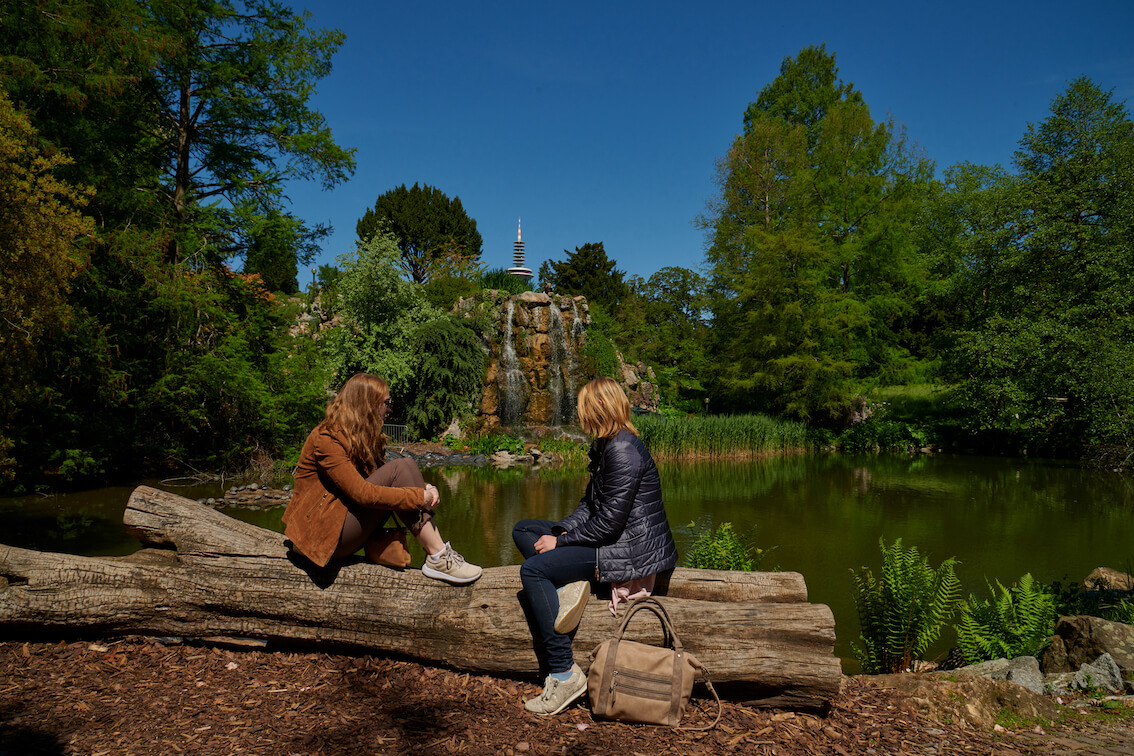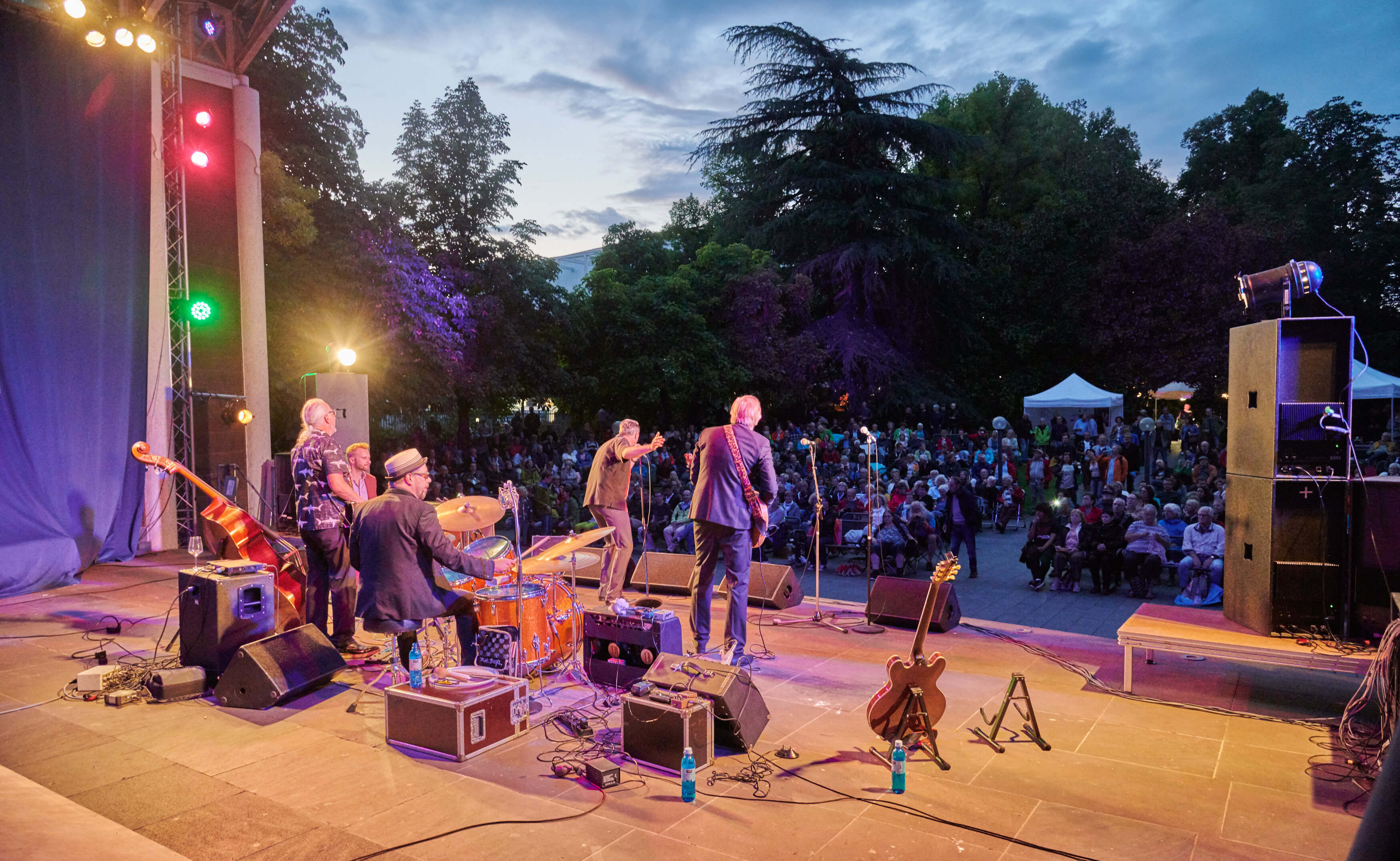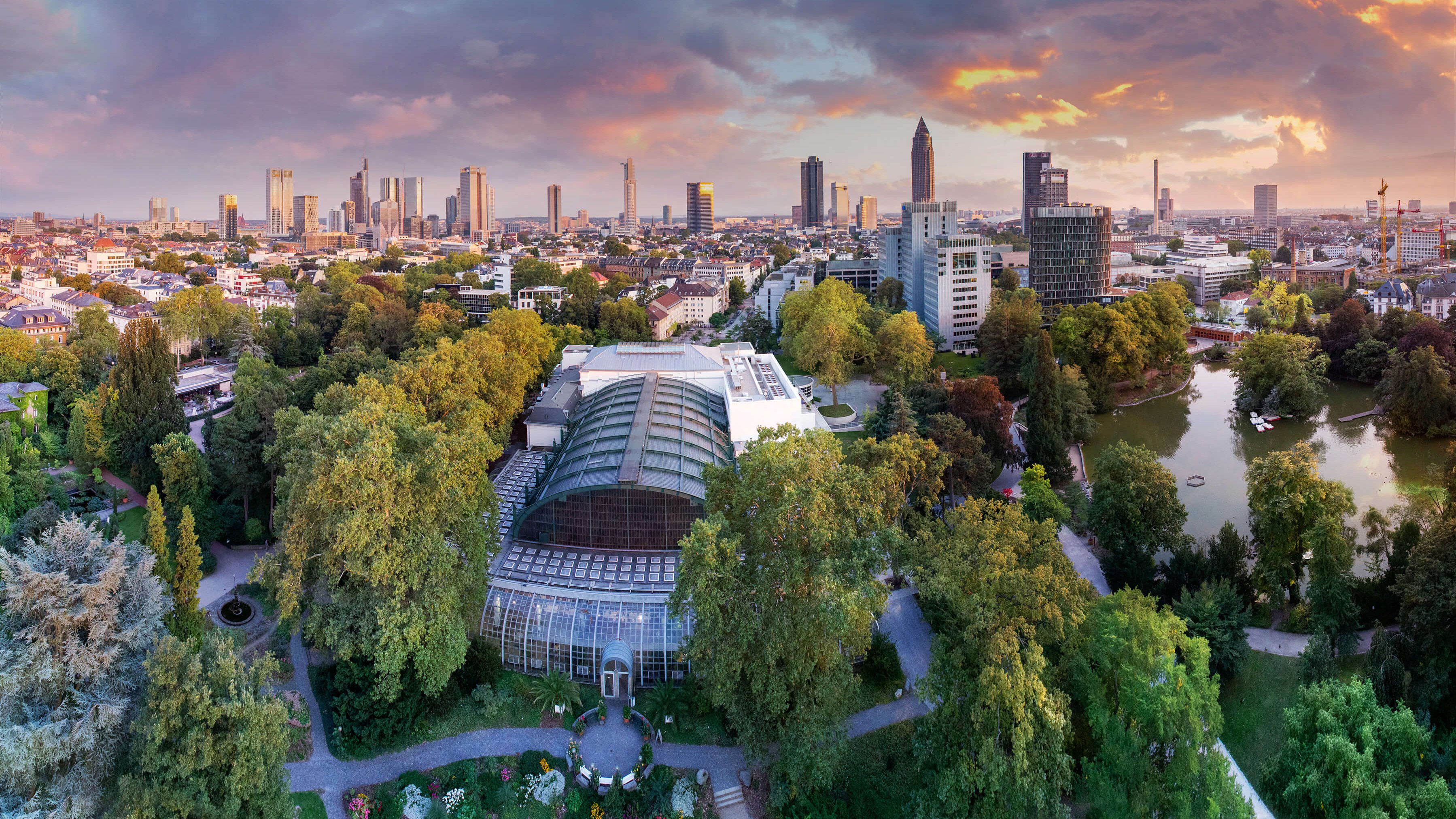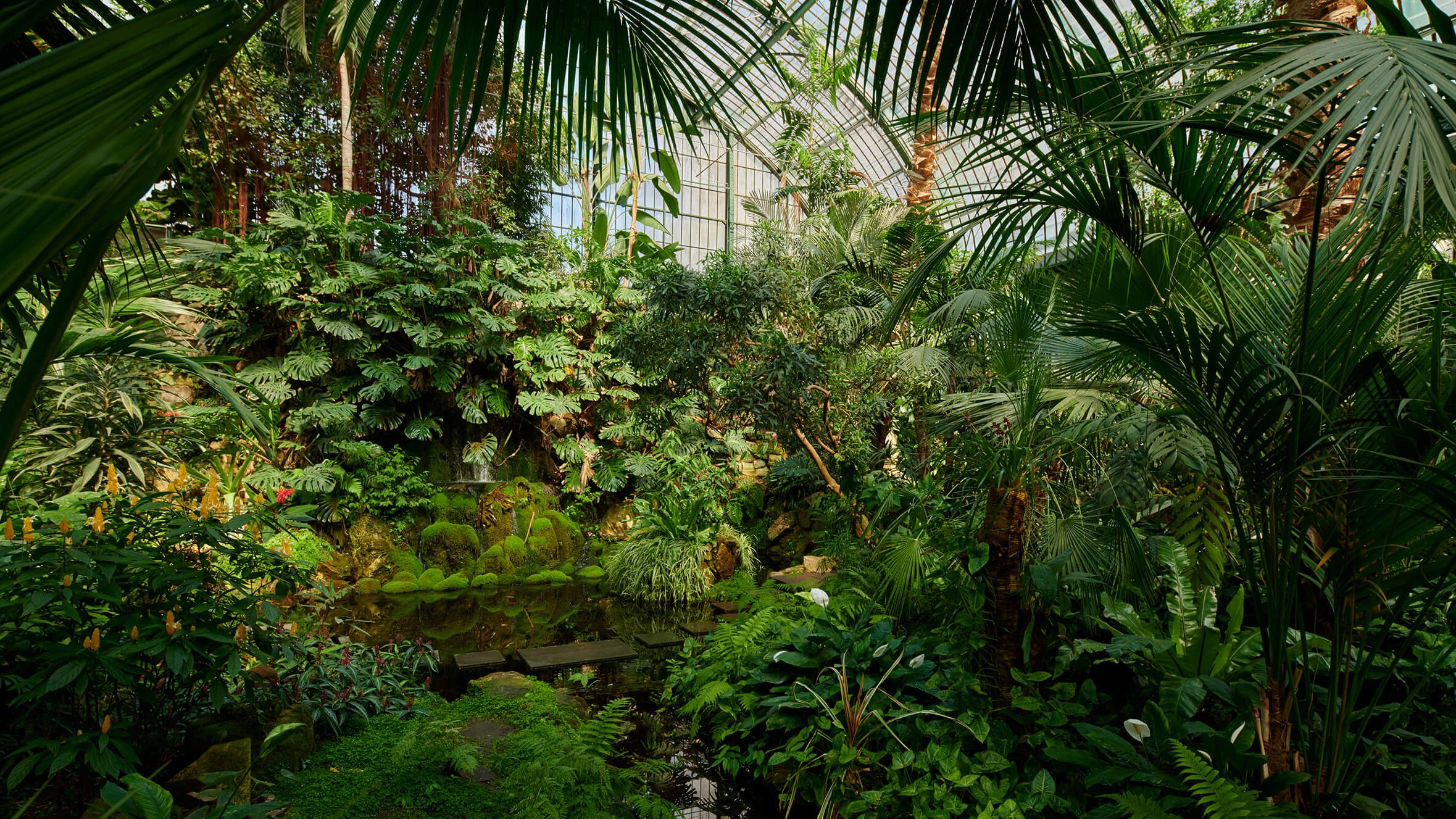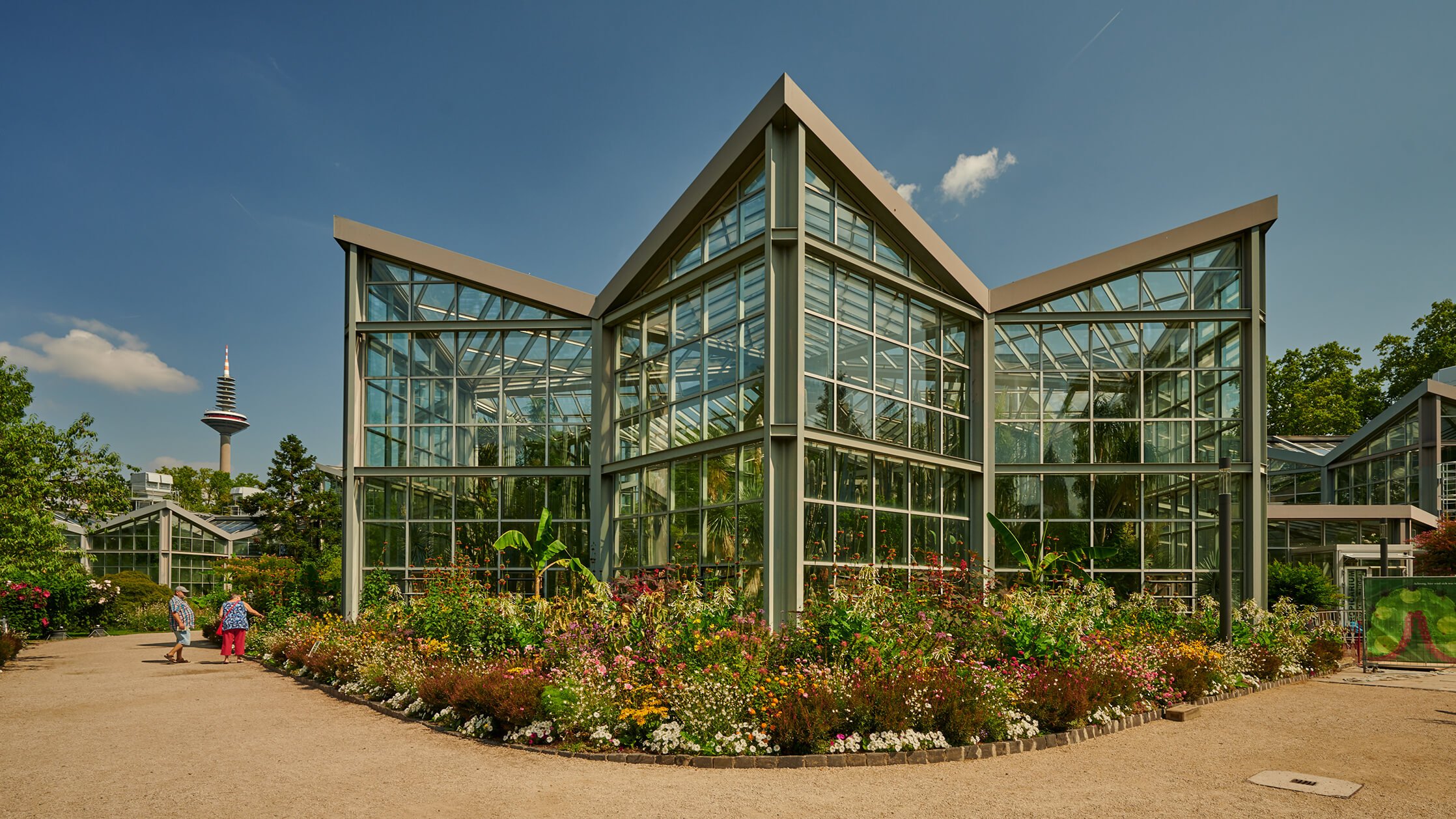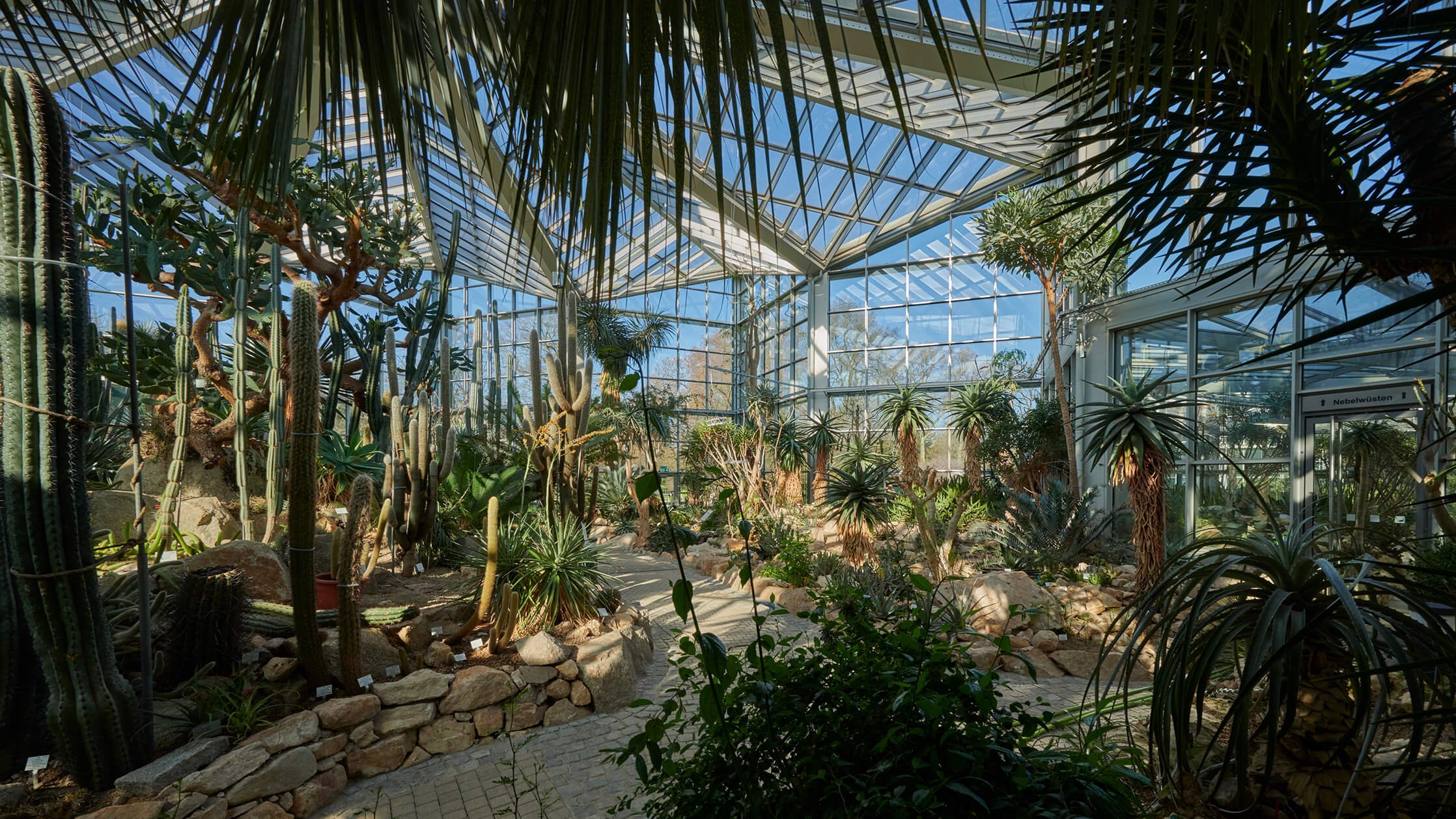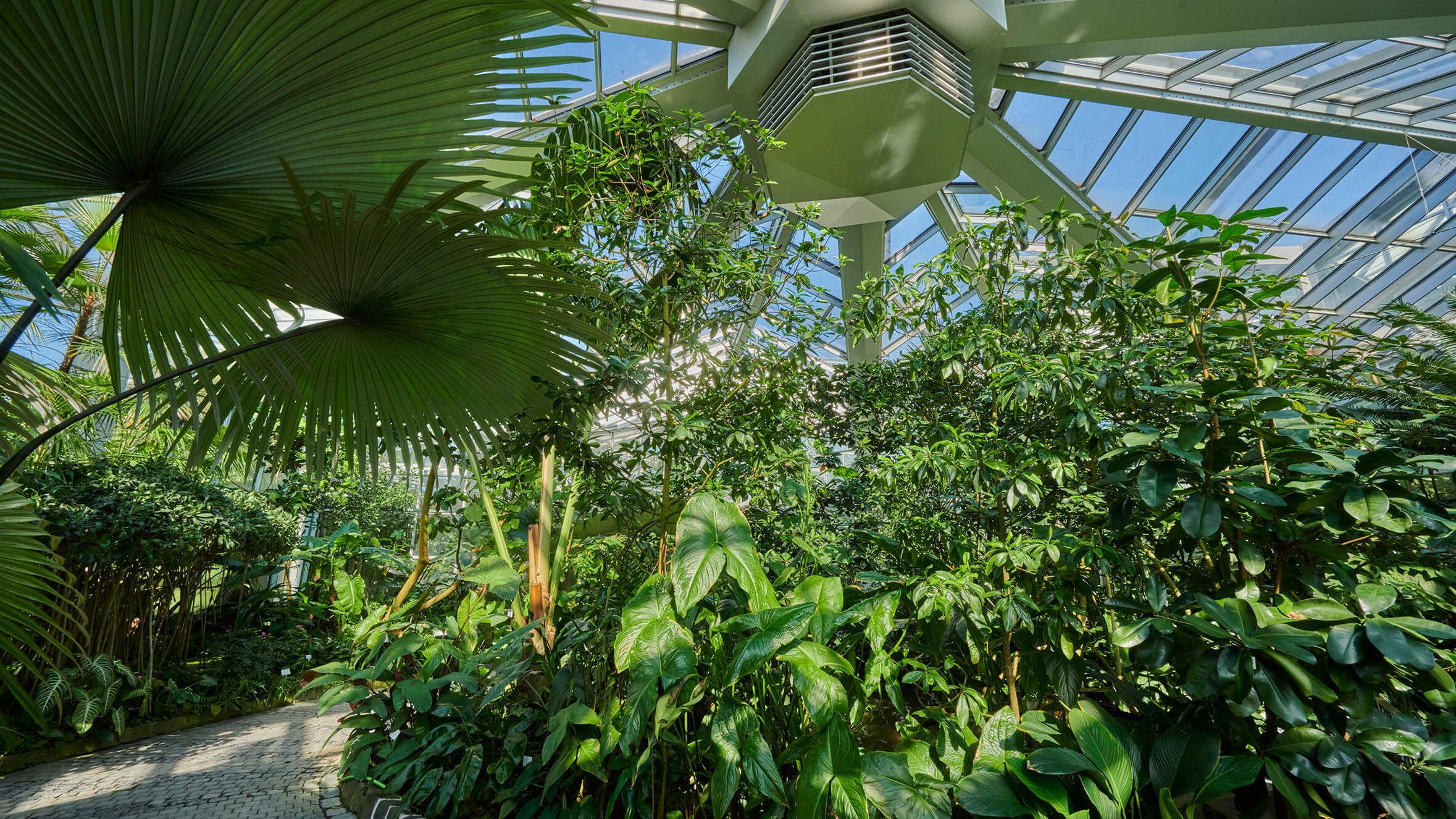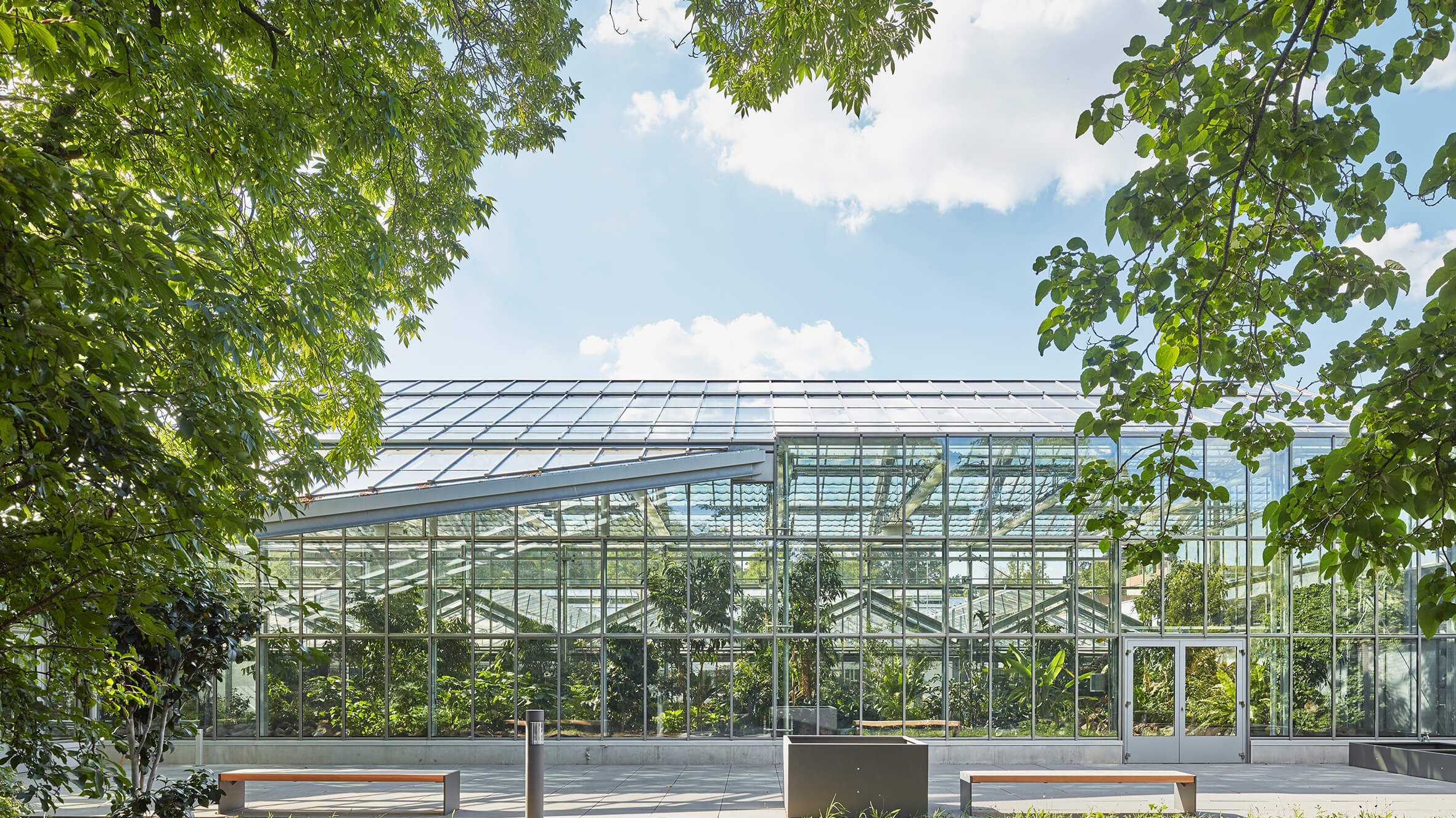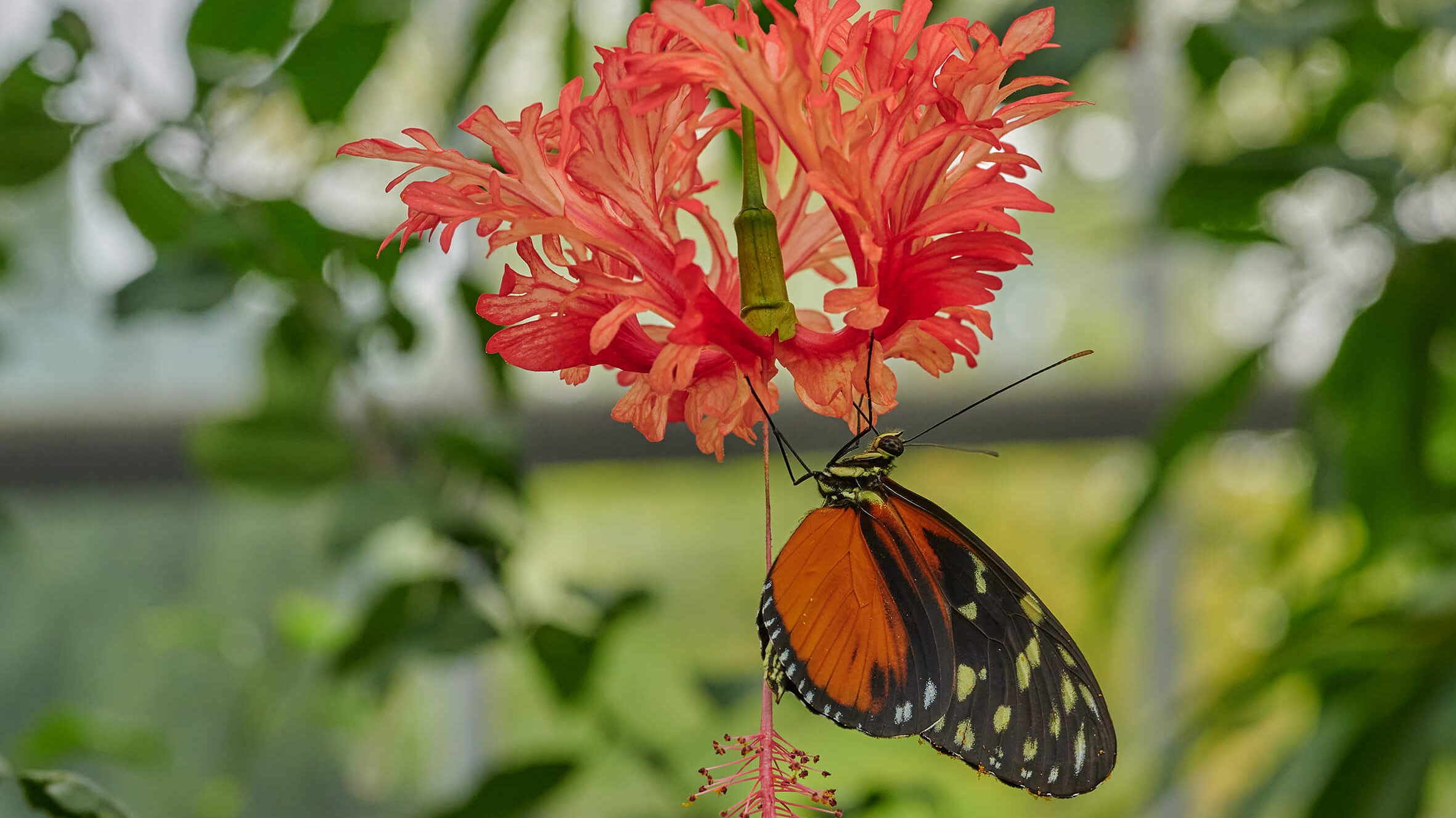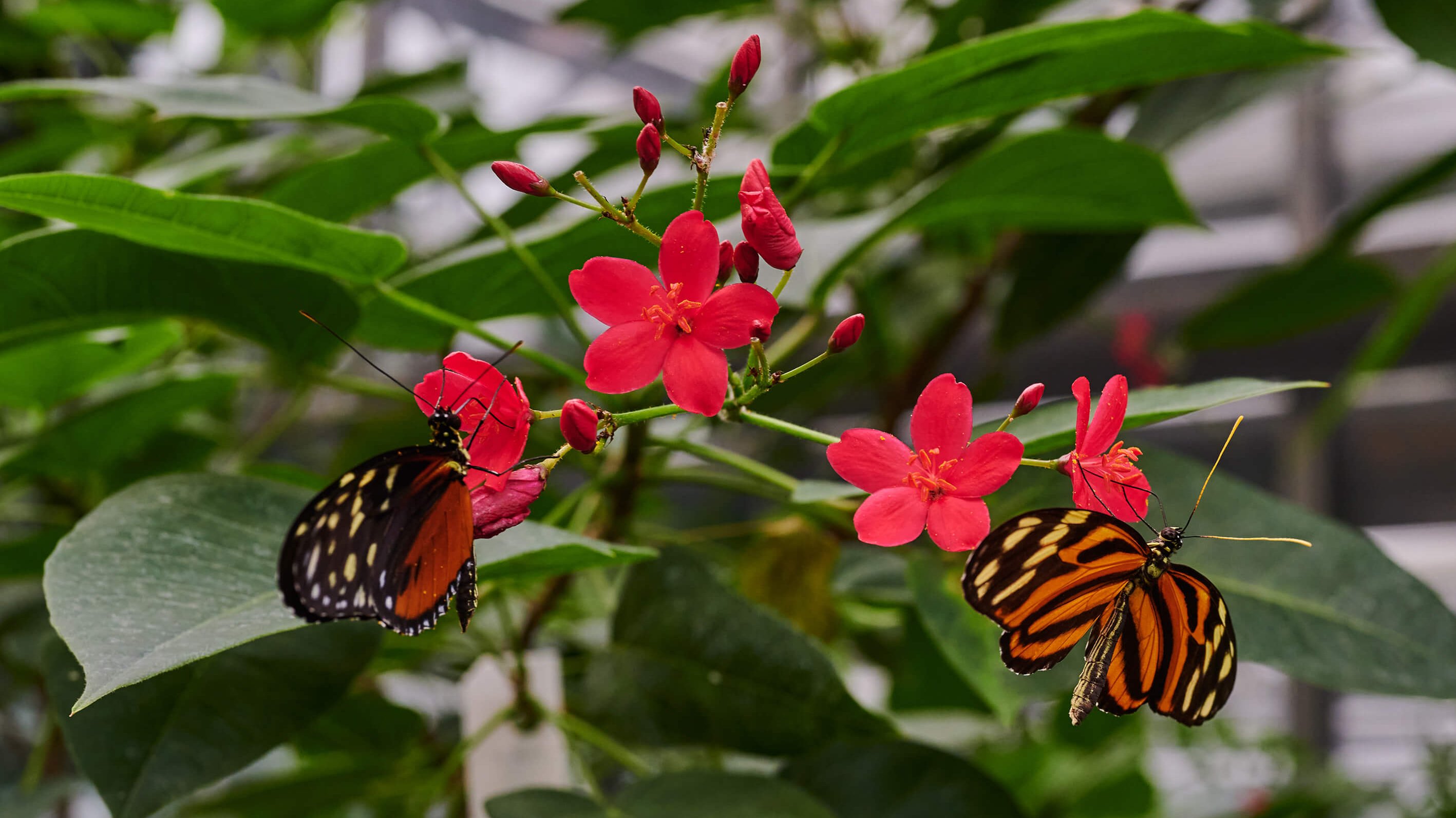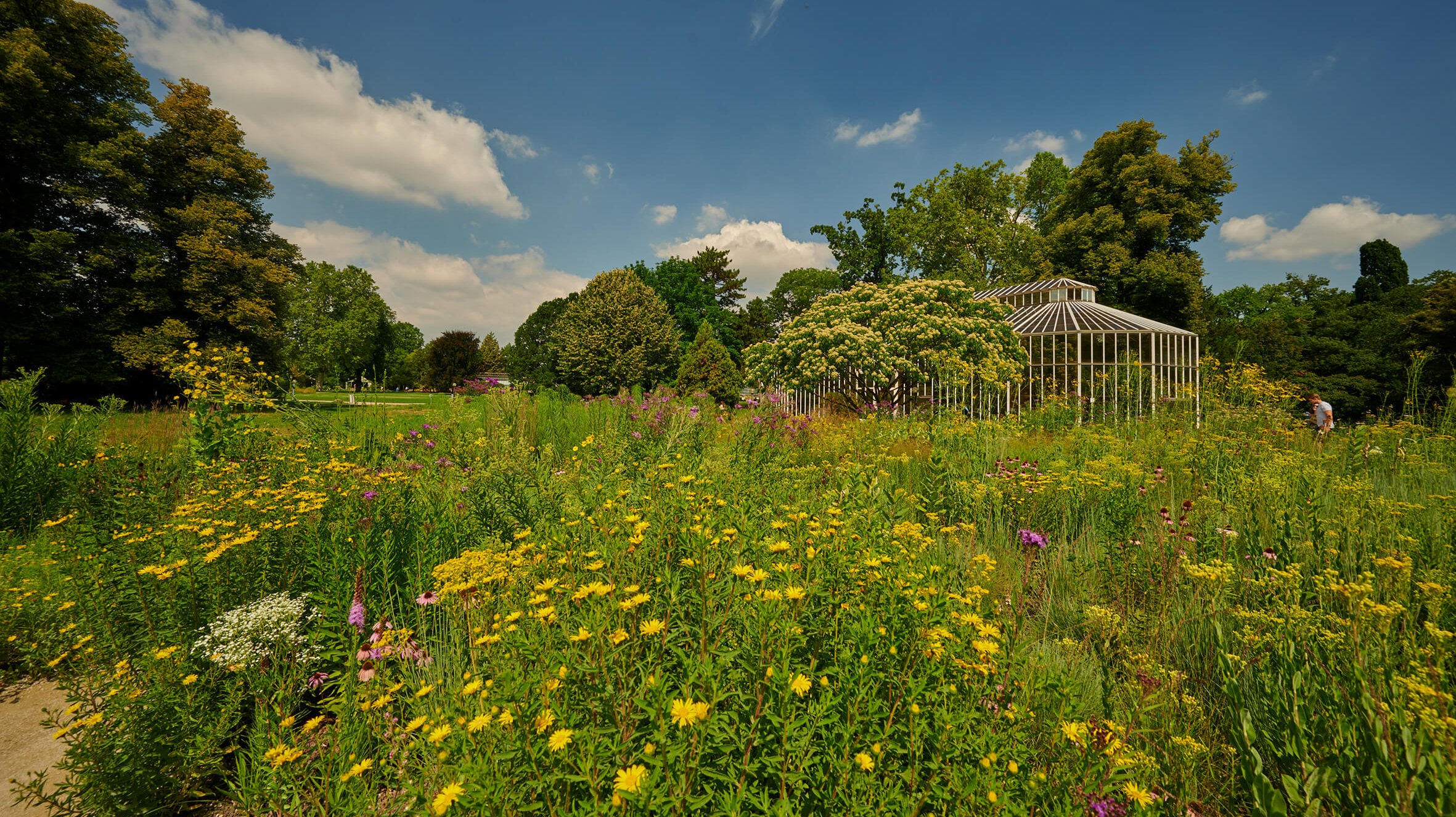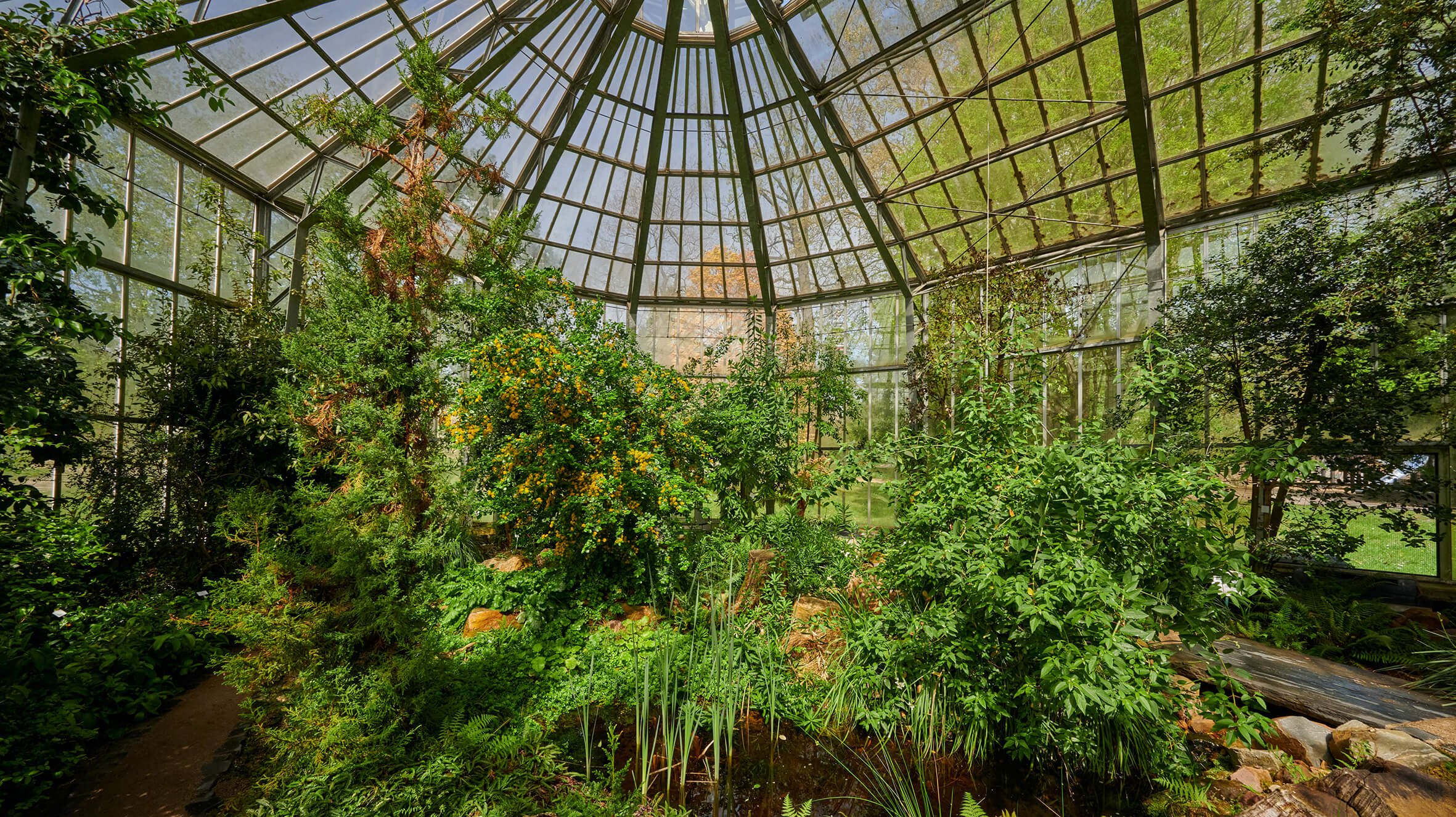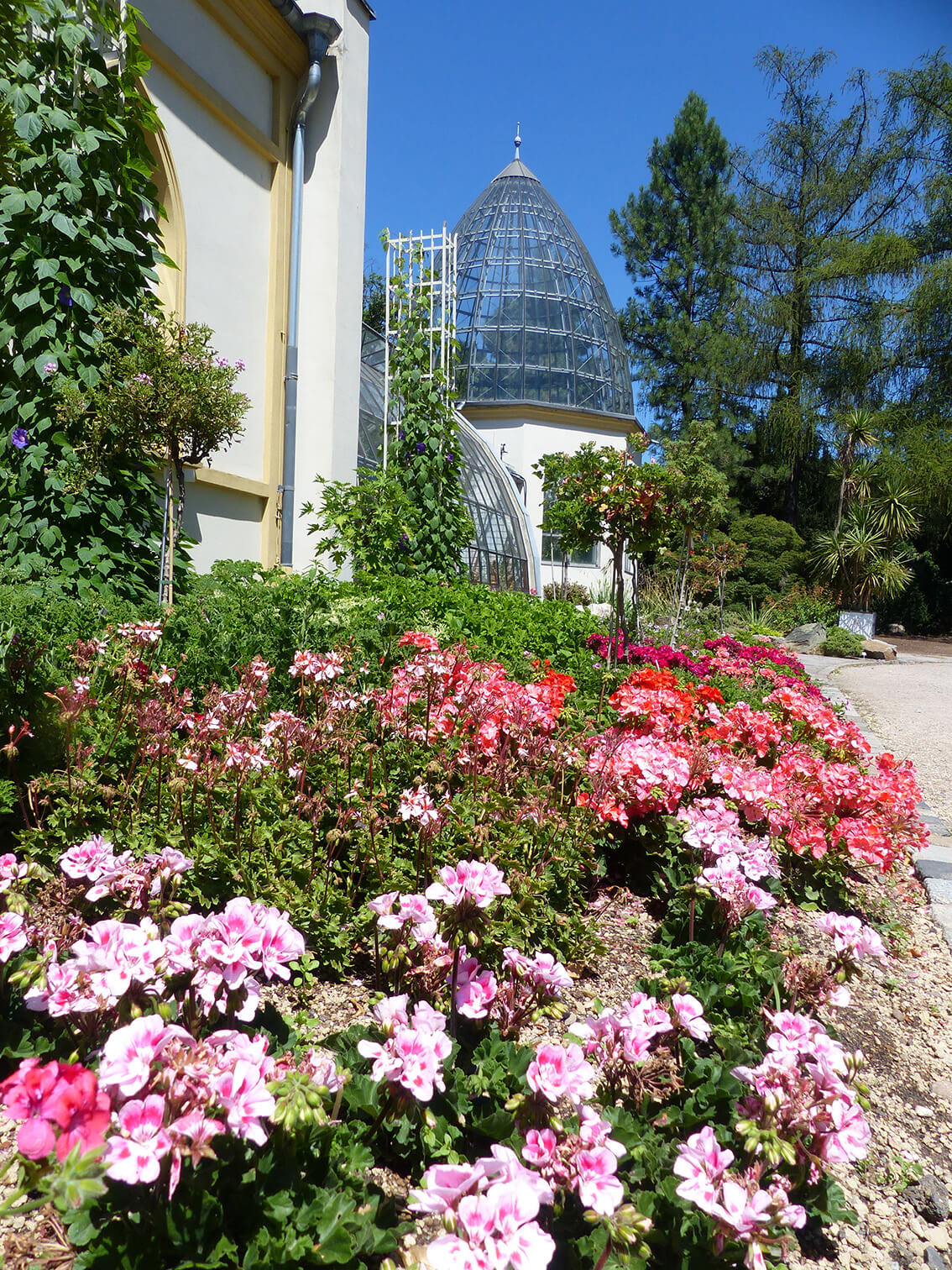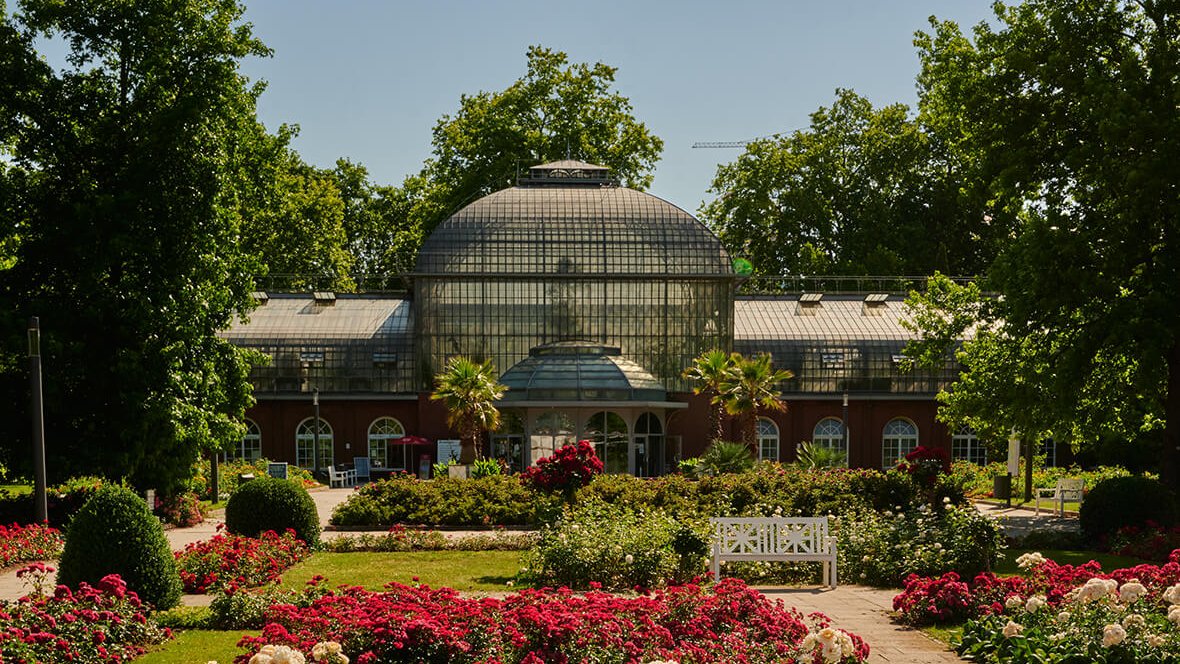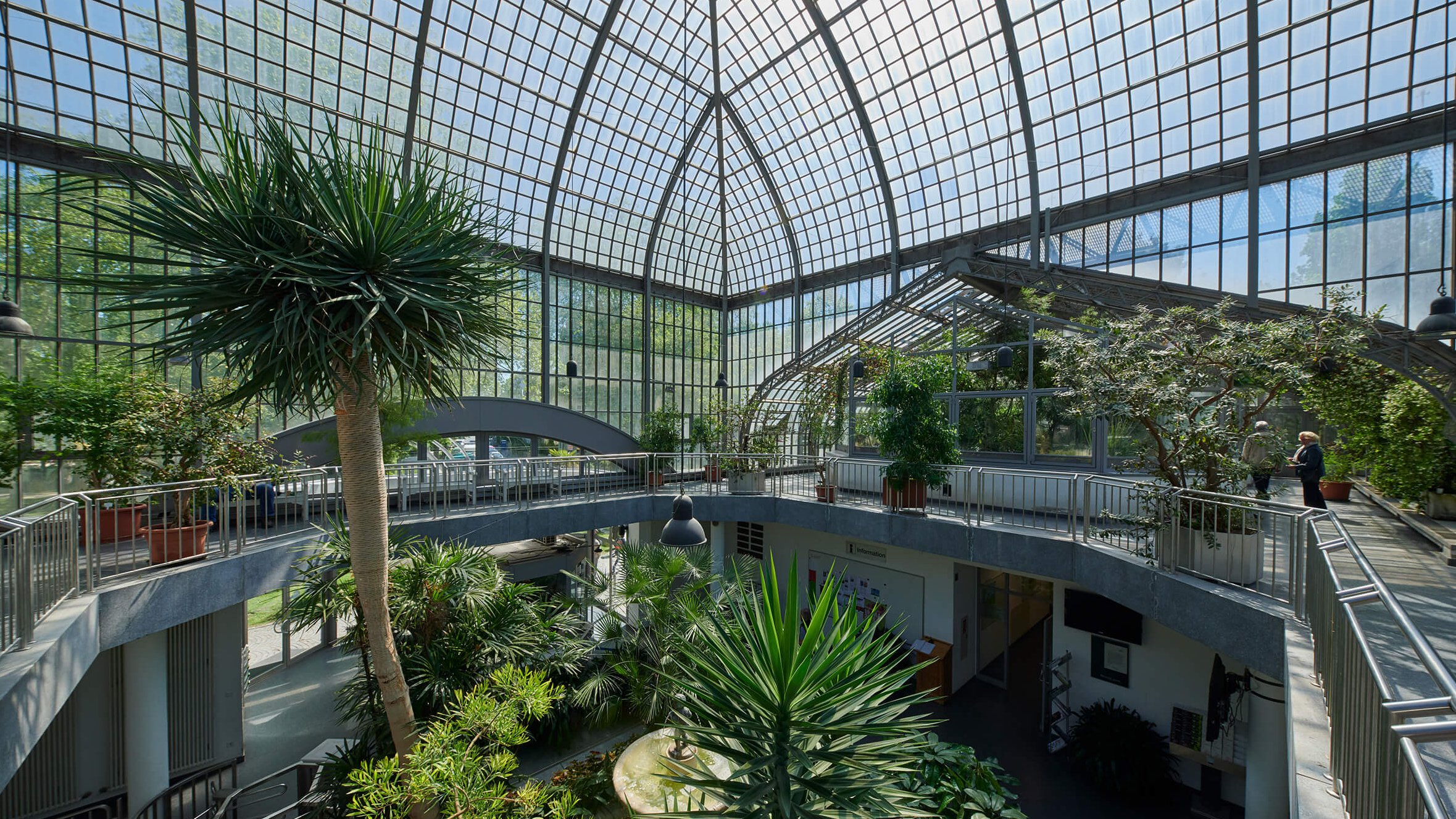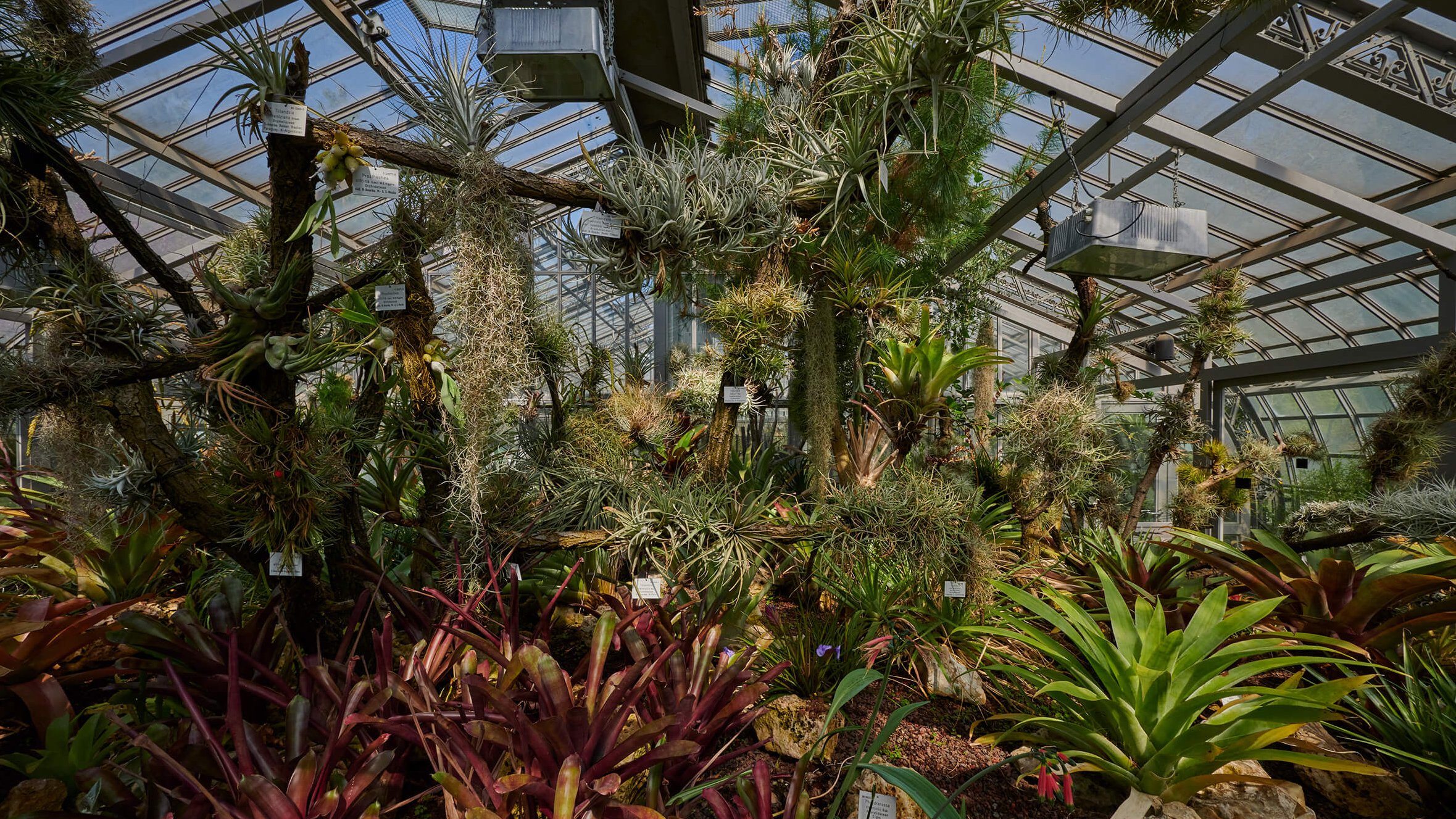Plants. Life. Culture
for 150 years
Old stands of trees and plants from all over the world; meadows and water; wilderness and knowledge; art and culture – the Palmengarten is a place without equal.
The garden covers 20 hectares and houses around 13,000 plant species in its outdoor areas and under the roofs of many, often historic, display houses. Exhibitions, topical guided tours, and musical events make the Palmengarten a major attraction at all seasons. And this not only includes human visitors: If you stroll past the garden’s meadows and flower beds on a sunny summer day, you will encounter numerous insects, including many species that are now rare. These, along with their importance for the ecosystem, are the subject of the Flower and Butterfly House, which is slated for opening in the summer of our anniversary year 2021. Here, visitors will be able to experience a butterfly’s life cycle, from the egg to the caterpillar and from pupa to the adult butterfly, and an adjacent exhibition, entitled “Dusted off,” provides information about the insects’ life and relevance. The visitors will also encounter our current guiding theme – flower ecology – in the exhibition, as well as in many other areas within the Palmengarten and the Botanical Garden, which became part of the Palmengarten in 2012.
Frankfurt’s citizens owe the establishment of the Palmengarten to a financial bottleneck and to the Prussians, who were not held in particularly high regard at the time. When Prussia annexed the Duchy of Nassau in 1866, the cash-strapped Adolph von Nassau was forced to sell some of his holdings – including the Winter Gardens of Biebrich with their collection of exotic plants. The duke commissioned the internationally renowned garden designer Heinrich Siesmayer with the search for a buyer. Siesmayer intended to bring the exotic plants to Frankfurt to use them for establishing a garden. To realize his idea of an artful yet naturally designed landscape garden, including a then revolutionary glasshouse filled with exotic plants, Siesmayer conceived the “Palmengarten shares.” Bankers, publishers, attorneys, and many wealthy citizens of Frankfurt bought these “shares,” thereby allowing Siesmayer’s vision to become reality.
Initially a meeting place for members of the upper middle class, the Palmengarten today is open to people of all ages, backgrounds, and interests. In addition to its astonishing diversity of plant and animal species, the garden has long been known far beyond regional borders for its cultural programs and events. Concerts from jazz to opera and pop, electronic music, sound art, photo exhibitions, collaborations with artists, traditional flower shows, events such as the Rose Festival and the Winter Lights, educational offers for visitors of all ages, from preschoolers to senior citizens – all of this is as much a part of the Palmengarten as its flower beds and greenhouses.
Palm Haus
The Palm House is the Palmengarten’s heart and showpiece, and it is even older than the garden itself. It was opened as early as November 1869, one-and-a-half years before the park was established.
According to the garden’s founder, Heinrich Siesmayer, the Palm House was to serve as a haven for exotic plants while at the same time offering Frankfurt’s society a place to gather and enjoy themselves. To this end, it combined an enormous winter garden with an anterior building, the Society House, including a glamorous ballroom that was restored to its original splendor after completion of the restoration work in 2012.
At the end of the 19th century, the construction of the Palm House was viewed as groundbreaking. A building made of steel and glass, designed on the basis of a patent from the 1867 World Expo in Paris – 52.6 meters long, 30.5 meters wide, with a maximum height of 18.5 meters, and all that without supporting pillars in the hall’s interior. To this day, the Palm House remains among the largest of its kind in Europe; at the time of its construction, it served as an example for many similar buildings in Germany.
Even today, 150 years after its opening, it has lost none of its attraction. There is hardly a visit to the Palmengarten that does not include a brief stop at the Palm House. Although the pathways through the interior have been rerouted, and the various palms that grow under its glass roof are no longer the same ones planted in Siesmayer’s days, the former shape remains unchanged. The pathways are bordered on the left and right by Washingtonia, fishtail, betel nut and Chamaedoria palms, araucarias, palm and tree ferns. The house’s anterior part contains a terrace, the posterior a water wall that splashes into a small basin inhabited by fishes. Behind this lies a grotto with fish tanks spanned by a gallery, and a small creek flows through the center of it all. Whether in the summer or winter, a visit to the Palm House always feels like a brief vacation.
Tropicarium
Built in the 1980s, this complex of buildings is still considered an outstanding architectural, technical, and conceptual masterpiece to this day. The Tropicarium displays tropical plants in their ecological context. The north wing is home to the vegetation of the humid tropics. It contains plants from the montane rain and cloud forests, evergreen lowland rainforests, semi-humid monsoon and trade-wind forests as well as mangrove and coastal forests. The south wing is home to the flora of the arid tropical regions: plants from dry forests and savannas, thorn forests, and semi-deserts and fog deserts.
Thus, visitors to the Tropicarium can embark on a botanical cruise around the world in just a short period of time. They can visit the Americas and Mexico with its meter-high spurges and giant mother-in-law’s cushions (barrel cacti) and, only a few feet down the trail, admire the rare Welwitschia mirabilis, which grows exclusively in the Namib desert and Southern Angola. The visitors walk past aloes and baobab trees from Madagascar as well as Australian palm ferns, macadamias, and grass trees. And these are only the so-called dry tropics. The neighboring complex, the humid tropics, contains black pepper bushes, cacao trees, lobster claws (Heliconia), giant bamboo, mangrove trees, bromeliads, the world’s largest orchid, sea coconuts from the Seychelles, red sealing wax palms, and a wide diversity of different palms and ferns in general.
The Tropicarium was the largest construction project in the Palmengarten’s history – and it still holds this superlative title today. It comprises a total of 14 greenhouses of various sizes and heights, the tallest reaching a height of 15 meters. A specially designed façade allows the development of an air heat cushion, which prevents cold condensation water from dripping on the plants during the winter. Obliquely tilted panes redirect vertical sunbeams, thereby protecting the plants from getting sunburned.
The Palmengarten’s botanical collection is located behind the public display houses. Here, the gardeners cultivate plants that often have a high scientific value, such as bromeliads, orchids, Amorphophallus species, and carnivorous plants. Visitors can sneak a peek inside these greenhouses from the outside.
Flower and Butterfly House
Visitors to the Palmengarten have long anticipated this event: On the occasion of our 150-year anniversary we are opening the Flower and Butterfly House (FBH). Starting in the summer, you will be able to study tropical butterflies up close and personal and learn about the interplay between flowers and their pollinators.
The FBH is an ensemble of glasshouses that comprises two separate areas – the Warm House and the Cold House. The Warm House is dedicated to the butterflies, their pupae, and caterpillars. The so-called pupae box contains butterfly pupae of various species; with a little luck, you may witness the hatching of a butterfly, observe how it literally unfolds its wings and makes its first attempt at flight. Adult butterflies frolic among nectar and food plants – and the visitors are allowed to meander right through the middle of this colorful world.
In the neighboring Cold House, the new exhibition “Dusted off – Of Flowers and their Visitors” examines the world of insects and other pollinators such as birds and mammals. It shows their diversity, their wealth of forms and colors, and their connection to the flora, which is essential for nature and humans – since butterflies, beetles, bees, and their ilk are important pollinators without whose services we would be unable to grow fruit, grains, or vegetables. This interplay between insects and plants is the focus of the Palmengarten’s guiding theme, flower ecology, and the exhibition in the FBH constitutes the topic’s core element.
In addition to information regarding pollination and the question what is actually contained in a flower, the exhibition illuminates the evolution of the interdependence between flowers and their pollinators. Why do pollinators visit flowers in the first place? How are they attracted, rewarded, or even fooled? How do insects see the world through their compound eyes, and what do flowers look like to them? These, and many other questions are answered by the exhibition, both theoretically and in a hands-on fashion – e.g., visitors can try to match different proboscises with different flowers. In the exhibition itself as well as in a small workshop, visitors young and old gain knowledge that they can immediately apply in many other areas in the Palmengarten and the Botanical Garden (and, of course, outside of the gardens as well).
Subantarctic House
Compared to other display houses in the Palmengarten, it is not very big, but it is almost unique: The Subantarctic House is dedicated to the flora of regions near the Antarctic, i.e., Patagonia, Tierra del Fuego, the Falkland Islands, and New Zealand’s South Island. Only in Tasmania can one encounter a similar display house.
Its construction style alone is remarkable, since it was built with parts of the former palm house in Bad Kissingen. After the spa city decommissioned the building in 1904, it found its way to the Palmengarten. Brownish SolStopp glass was installed between the steel girders; the panes prevent the intrusion of warming infrared rays. In addition, automated ventilation and fog systems ensure that the summer temperature in the Subantarctic House always remains around 8 degrees below the outside temperature.
The plants inside the house prefer a moist and fresh atmosphere. The path to the left of the entrance takes visitors to Southern Chile, Patagonia, Tierra del Fuego, and the Falkland Islands, where they can find Guaitecas cypresses, alpine water ferns, various species of bamboo, Chile’s national plant – the Chilean bellflower, Lapageria rosea – as well as the Patagonian cypress, also known as alerce.
Walk a few meters farther, and you reach the South Island of New Zealand and its neighboring islands in the South Pacific, whose flora is represented to the right of the entrance. It is characterized by several species of southern beech (Nothofagus), plum pines (Podocarpus), Astelia species, leather flowers (Clematis), and tree ferns.
Alpinhäsuer
The side aisles to the left and right of the Leonhardsbrunn House contain non-hardy plants from mountain regions across the globe. The eastern side aisle represents the vegetation of the southern hemisphere, including plants from the Andes, the Drakensberg range, and the New Zealand Alps. The western side aisle houses plants from the Alps, the Atlas mountains, the Rocky Mountains, and the Caucasus – i.e., the northern hemisphere. In addition, species from the Himalayas and the Pyrenees as well as the mountain flora of Crete, South Africa, and Morocco can be found in the Alpine Houses.
You may wonder why these plants are not hardy – after all, in their natural range they occur in areas with long and severe winters. The answer can be found in Frankfurt’s climate. Some plants require a layer of snow that covers them like a warming blanket; for others, it is too wet or simply too cold, so that they need a protective glass roof.
A crevice garden is located outside in front of the Alpine Houses, where visitors can admire yellow-blooming Daphne, houseleek, edelweiss, hebes from New Zealand, angel’s fishing rod, and New Zealand bur.
Entrance Display House
When entering the Palmengarten via Siesmayerstrasse, you pass through a building that was erected in 1906 as part of a new complex of display and greenhouses. Once the Tropicarium was constructed in the 1980s, these buildings became obsolete. Only the former central hall with a 15-meter-high glass dome remained. It was rotated by 90 degrees and reconstructed as the Entrance Display House.
On the upper level located to the right and left of the dome construction, curious visitors can find our exciting collections of carnivorous plants and tillandsias – both well-known attractions in the Palmengarten.
The carnivorous plants, i.e., plants that catch insects, such as the Venus flytrap, sundews, sun pitchers, pitcher plants, and monkey cups, are housed in the building’s south wing. Information boards explain the various mechanisms employed by the plants to trap insects and arthropods, and occasionally even small vertebrates. In some plants, the insects stick to the leaves; in others, they cannot escape since the plant snaps shut; and certain plants even suck in their prey – an eerily beautiful flora!
The north wing contains the Palmengarten’s collection of tillandsias, the largest genus within the bromeliad family (which includes the pineapple). The majority are epiphytes, i.e., they grow on tree branches and not in the soil. Bromeliads (including the tillandsias) originate in Central and South America, but they have been cultivated in the Palmengarten since its beginnings – a list from the year 1898 contains 26 tillandsia species. In addition to the tillandsias, the north wing also contains several species of Hechtia, another genus in the bromeliad family. Hechtias are covered with nasty spines and occur from southern Texas to northern Nicaragua, with most species found in Mexico.

